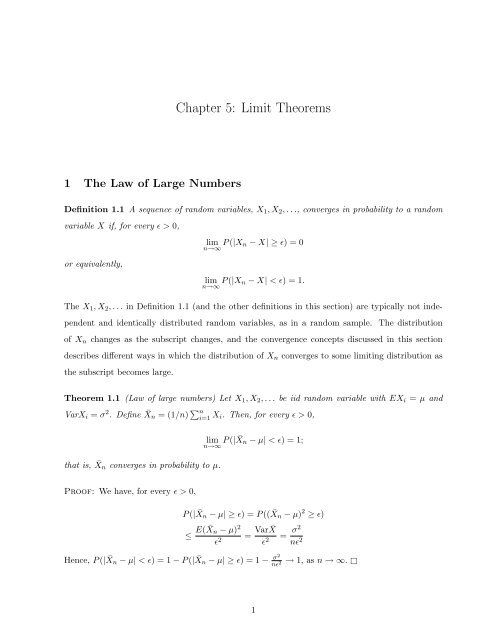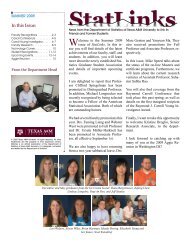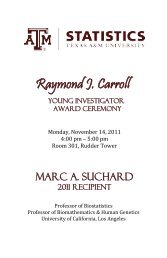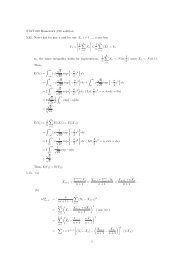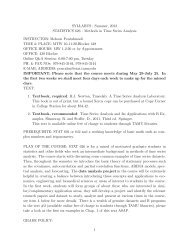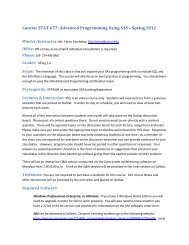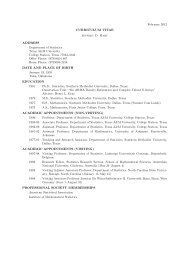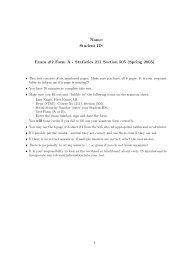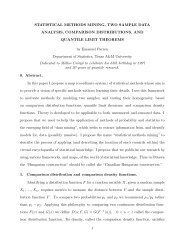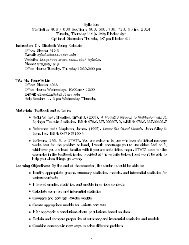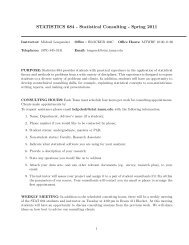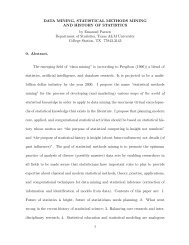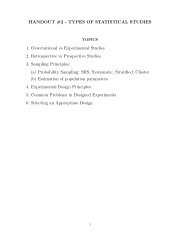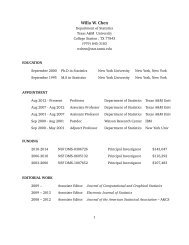Chapter 5: Limit Theorems
Chapter 5: Limit Theorems
Chapter 5: Limit Theorems
Create successful ePaper yourself
Turn your PDF publications into a flip-book with our unique Google optimized e-Paper software.
<strong>Chapter</strong> 5: <strong>Limit</strong> <strong>Theorems</strong><br />
1 The Law of Large Numbers<br />
Definition 1.1 A sequence of random variables, X 1 , X 2 , . . ., converges in probability to a random<br />
variable X if, for every ɛ > 0,<br />
or equivalently,<br />
lim P (|X n − X| ≥ ɛ) = 0<br />
n→∞<br />
lim P (|X n − X| < ɛ) = 1.<br />
n→∞<br />
The X 1 , X 2 , . . . in Definition 1.1 (and the other definitions in this section) are typically not independent<br />
and identically distributed random variables, as in a random sample. The distribution<br />
of X n changes as the subscript changes, and the convergence concepts discussed in this section<br />
describes different ways in which the distribution of X n converges to some limiting distribution as<br />
the subscript becomes large.<br />
Theorem 1.1 (Law of large numbers) Let X 1 , X 2 , . . . be iid random variable with EX i = µ and<br />
VarX i = σ 2 . Define ¯X n = (1/n) ∑ n<br />
i=1 X i. Then, for every ɛ > 0,<br />
that is, ¯Xn converges in probability to µ.<br />
lim P (| ¯X n − µ| < ɛ) = 1;<br />
n→∞<br />
Proof: We have, for every ɛ > 0,<br />
P (| ¯X n − µ| ≥ ɛ) = P (( ¯X n − µ) 2 ≥ ɛ)<br />
≤ E( ¯X n − µ) 2<br />
ɛ 2<br />
=<br />
Var ¯X<br />
ɛ 2<br />
Hence, P (| ¯X n − µ| < ɛ) = 1 − P (| ¯X n − µ| ≥ ɛ) = 1 − σ2<br />
nɛ 2<br />
= σ2<br />
nɛ 2<br />
→ 1, as n → ∞. □<br />
1
The law of large numbers (also known as the weak law of large numbers or WLLN) quite elegantly<br />
states that under general conditions, the sample mean approaches the population mean as n → ∞.<br />
A type of convergence that is stronger than convergence in probability is almost sure convergence.<br />
This type of convergence is similar to pointwise convergence of a sequence of functions,<br />
except that the convergence need not occur on a set with probability 0 (hence the “almost” sure).<br />
EX A (Consistency of S 2 ) Suppose we have a sequence X 1 , X 2 , . . . of iid random variables with<br />
EX i = µ and VarX i = σ 2 < ∞. If we define<br />
using Chebychev’s Inequality, we have<br />
S 2 n = 1<br />
n − 1<br />
n∑<br />
(X i − ¯X n ) 2 ,<br />
i=1<br />
P (|S 2 − σ 2 | ≥ ɛ) ≤ E(S2 n − σ 2 ) 2<br />
ɛ 2<br />
= VarS2 n<br />
ɛ 2 ,<br />
and thus, a sufficient condition that S 2 n converges in probability to σ 2 is that VarS 2 n → 0 as<br />
n → ∞.<br />
EX B (Monte Carlo Integration) Suppose that we wish to calculate<br />
I(f) =<br />
∫ 1<br />
0<br />
f(x)dx<br />
where the integration can not be done by elementary means.<br />
The Monte Carlo method<br />
works in the following way. Generate independent uniform random variables on [0, 1]—that<br />
is, X 1 , . . . , X n —and compute<br />
Î(f) = 1 n<br />
n∑<br />
f(X i ).<br />
By the law of large numbers, this should be close to E[f(x)] = ∫ 1<br />
0 f(x)dx.<br />
i=1<br />
2 Convergence in Distribution and the Central <strong>Limit</strong> Theorem<br />
Definition 2.1 A sequence of random variables, X 1 , X 2 , . . ., converges in distribution to a random<br />
variable X if<br />
at all points x where F X (x) is continuous.<br />
lim F X<br />
n→∞ n<br />
(x) = F X (x)<br />
2
EX A (Maximum of uniforms) If X 1 , X 2 , . . . are iid uniform(0,1) and X (n) = max 1≤i≤n X i , let us<br />
examine if X (n) converges in distribution.<br />
As n → ∞, we have for any ɛ > 0,<br />
P (|X n − 1| ≥ ɛ) = P (X (n) ≤ 1 − ɛ)<br />
= P (X i ≤ 1 − ɛ, i = 1, . . . , n) = (1 − ɛ) n ,<br />
which goes to 0. However, if we take ɛ = t/n, we then have<br />
P (X (n) ≤ 1 − t/n) = (1 − t/n) n → e −t ,<br />
which, upon rearranging, yields<br />
P (n(1 − X (n) ) ≤ t) → 1 − e −t ;<br />
that is, the random variable n(1−X (n) ) converges in distribution to an exponential(1) random<br />
variable.<br />
Moment-generating function are often useful for establishing the convergence of distribution<br />
functions. We know from chapter 4 that a distribution function F n is uniquely determined by its<br />
mgf, M n . The following theorem states that this unique determination holds for limit as well.<br />
Theorem 2.1 (Continuity Theorem) Let F n be a sequence of cumulative distribution functions with<br />
the corresponding moment-generating function M n . Let F be a cumulative distribution function with<br />
the moment-generating function M. If M n (t) → M(t) for all t in an open interval containing zero,<br />
then F n (x) → F (x) at all continuity points of F .<br />
EX B We will show that the Poisson distribution can be approximated by the normal distribution<br />
for large values of λ.<br />
Let λ 1 , λ 2 , . . . be an increasing sequence with λ n → ∞, and let {X n } be a sequence of Poisson<br />
random variables with the corresponding parameters. We know that E(X n ) = Var(X n ) = λ n .<br />
Let<br />
Z n = X n − λ n<br />
√<br />
λn<br />
,<br />
we then have E(Z n ) = 0 and Var(Z n ) = 1, and we will show that the mgf of Z n converges to<br />
the mgf of standard normal distribution.<br />
3
The mgf of X n is ψ Xn (t) = e λn(et −1) . The mgf of Z n is then<br />
ψ Zn (t) = e −t√ λ n<br />
t<br />
ψ Xn ( √ )<br />
λn<br />
= e −t√ λ n<br />
e λn(et/√ λn−1)<br />
= e t2 2 + t3<br />
3! √ λn +···.<br />
Thus, lim n→∞ ψ Zn (t) = e t2 /2 , which concludes the proof.<br />
EX C A certain type of particle is emitted at a rate of 900 per hour. What is the probability that<br />
more than 950 particles will be emitted in a given hour if the counts form a Poisson process?<br />
Let X be a Poisson random variable with mean 900. By Example B, we have<br />
P (X > 950) = P ( X √ − 900 950 − 900<br />
> √ ) ≈ 1 − Φ(5/3) = 0.04779.<br />
900 900<br />
For comparison, the exact probability is 0.04712.<br />
Theorem 2.2 (Central limit theorem) Let X 1 , X 2 , . . . be a sequence of iid random variables whose<br />
mgfs exist in a neighborhood of 0 (that is, M Xi (t) exists for |t| < h, for some positive h). Let<br />
EX i = 0 and VarX i = σ 2 . Define S n = ∑ n<br />
i=1 X i. Then, for any x, −∞ < x < ∞,<br />
( )<br />
lim P Sn<br />
n→∞ σ √ n ≤ x = Φ(x).<br />
Proof: Let Z n = S n /(σ √ n). We will show that the mgf of Z n tends to the mgf of the standard<br />
normal distribution. Since S n is a sum of independent normal random variables,<br />
and<br />
ψ(s) has a Taylor expansion about zero:<br />
ψ Sn (t) = [ψ(t)] n<br />
ψ Zn (t) =<br />
[ ( )] t<br />
ψ<br />
σ √ .<br />
n<br />
ψ(s) = ψ(0) + sψ ′ (0) + 1 2 s2 ψ ′′ (0) + ɛ s ,<br />
where ɛ s /s 2 → 0 as s → 0. Since ψ ′ (0) = 0 and ψ ′′ (0) = σ 2 ,<br />
( ) t<br />
ψ<br />
σ √ = 1 + 1 ( ) t 2<br />
n 2 σ2 σ √ + ɛ n ,<br />
n<br />
where ɛ n /(t 2 /(nσ 2 )) → 0 as n → ∞. We thus have<br />
) n<br />
ψ Zn (t) =<br />
(1 + t2<br />
2n + ɛ n .<br />
4
It can be shown that if a n → a, then<br />
lim (1 + a n<br />
n→∞ n )n = e a .<br />
From this result, it follows that<br />
ψ Zn (t) → e t2 /2 , as n → ∞,<br />
which concludes the proof. □<br />
The above theorem is one of the simplest versions of the central limit theorem; there are many<br />
central limit theorems of various degrees of abdtraction and generality. We have proved the above<br />
theorem under the assumption that the moment-generating function exist, which is a rather strong<br />
assumption. The next theorem only requires that the first and second moments exist.<br />
Theorem 2.3 (Stronger form of the central limit theorem) Let X 1 , X 2 , . . . be a sequence of iid<br />
random variables with EX i = µ and 0 < VarX i = σ 2 < ∞. Define ¯X n = ( 1 n ) ∑ n<br />
i=1 X i. Let G n (x)<br />
denote the cdf of √ n( ¯X n − µ)/σ. Then, for any x, −∞ < x < ∞,<br />
∫ x<br />
lim G 1<br />
n(x) = √ e −y2 /2 dy;<br />
n→∞<br />
−∞ 2π<br />
that is, √ n( ¯X n − µ)/σ has a limiting standard normal distribution.<br />
EX D Because the uniform distribution on [0, 1] has mean 1/2 and variance 1/12, the sum of 12<br />
uniform random variables, minus 6, has mean 0 and variance 1. The distribution of this sum<br />
is quite close to normal; in fact, before better algorithms were developed, it was commonly<br />
used in computers for generating normal random variables from uniform ones.<br />
Figure 5.1 shows a histogram of 1000 such sums with a superimposed normal density function.<br />
EX E The sum of n independent random variables with parameter λ = 1 follows a gamma distribution<br />
with λ = 1 and α = n. The exponential density is quite skewed; therefore, a good<br />
approximation of a standardized gamma by a standardized normal would not be expected for<br />
small n. Figure ?? shows that the approximation to normal improves as n increases.<br />
EX F Since a binomial random variable is the sum of independent bernoulli random variables, its<br />
is distribution can be approximated by a normal distribution. The approximation is best<br />
when the binomial distribution is symmetric—that is, when p = 1/2.<br />
A frequently used<br />
5
Figure 1: A histogram of 1000 values, each of which is the sum of 12 uniform [−0.5, 0.5]<br />
random variables.<br />
Figure 2: The standard normal cdf (solid line) and the cdf’s of standardized gamma distributions<br />
with α = 5 (log dashed), α = 10 (short dashed), and α = 30 (dots).<br />
6
ule of thumb is that the approximation is reasonable when np > 5 and n(1 − p) > 5. The<br />
approximation is especially useful for large values of n.<br />
Suppose that a coin is tossed 100 times and lands heads up 60 times. Should we be supprised<br />
and doubt that the coin is fair?<br />
P (X ≥ 60) = P<br />
( )<br />
X − 50 100 − 50<br />
√ ≥ √<br />
25 25<br />
≈ 1 − Φ(2)<br />
= 0.0228<br />
The probability is rather small, so the fairness of the coin is called into question.<br />
7


